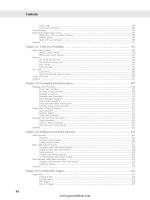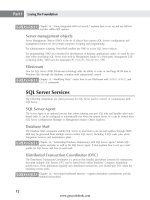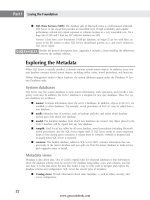Hướng dẫn học Microsoft SQL Server 2008 part 25 pot
Bạn đang xem bản rút gọn của tài liệu. Xem và tải ngay bản đầy đủ của tài liệu tại đây (544.91 KB, 10 trang )
Nielsen c09.tex V4 - 07/21/2009 12:40pm Page 202
Part II Manipulating Data With Select
Case expressions
SQL Server’s CASE expression is a flexible and excellent means of building dynamic expressions.
If you’re a programmer, no doubt you use the case command in other languages. The SQL
CASE
expression, however, is different. It’s not used for programmatic flow of control, but rather to logically
determine the value of an expression based on a condition.
Best Practice
W
hen programmers write procedural code, it’s often because part of the formula changes depending on
the data. To a procedural mind-set, the best way to handle this is to loop through the rows and use
multiple IF statements to branch to the correct formula. However, using a CASE expression to handle the
various calculations and executing the entire operation in a single query enables SQL Server to optimize
the process and make it
dramatically
faster.
Because the case expression returns an expression, it may be used anywhere in the SQL DML
statement (
SELECT, INSERT, UPDATE, DELETE) where an expression may be used, including column
expressions, join conditions, where conditions, having conditions, in the
ORDER BY, or even embedded
in a longer expression. A case expression can even be used mid-expression to create a dynamic formula
– very powerful.
The
CASE statement has two forms, simple and searched, described in the following sections.
Simple case
With the simple CASE, the variable is presented first and then each test condition is listed. However,
this version of
CASE is limited in that it can perform only equal comparisons. The CASE expression
sequentially checks the
WHEN conditions and returns the THEN value of the first true WHEN condition.
In the following example, based on the OBXKites database, one
CustomerType is the default for new
customers and is set to
true in the IsDefault column. The CASE expression compares the value in
the default column with each possible bit setting and returns the character string
‘default type’ or
‘possible’ basedonthebitsetting:
USE OBXKites;
SELECT CustomerTypeName,
CASE IsDefault
WHEN 1 THEN ‘default type’
WHEN 0 THEN ‘possible’
ELSE ‘-’
END AS AssignStatus
FROM CustomerType;
202
www.getcoolebook.com
Nielsen c09.tex V4 - 07/21/2009 12:40pm Page 203
Data Types, Expressions, and Scalar Functions 9
Result:
CustomerTypeName AssignStatus
Preferred possible
Wholesale possible
Retail default type
The CASE expression concludes with an end and an alias. In this example, the CASE expression evalu-
ates the
IsDefault column, but produces the AssignStatus column in the SQL SELECT result set.
Be careful if you use
NULL in a simple CASE. This translates literally to ‘‘=NULL’’ and not to ‘‘IS NULL’’.
You can get unintended results if you are not careful.
Boolean case
The Boolean form of case (called the searched case in BOL) is more flexible than the simple form in
that each individual case has its own Boolean expression. Therefore, not only can each
WHEN condition
include comparisons other than
=, but the comparison may also reference different columns:
SELECT
CASE
WHEN 1<0 THEN ‘Reality is gone.’
WHEN CURRENT_TIMESTAMP = ‘20051130’
THEN ‘David gets his driver’’s license.’
WHEN 1>0 THEN ‘Life is normal.’
END AS RealityCheck;
Following is the result of the query when executed on David’s sixteenth birthday:
RealityCheck
David gets his driver’s license.
As with the simple case, the first true WHEN condition halts evaluation of the case and returns the THEN
value. In this case (a pun!), if 1 is ever less than 0, then the RealityCheck case will accurately report
‘reality is gone.’ When my son turns 16, the RealityCheck will again accurately warn us of
his legal driving status. If neither of these conditions is true, and 1 is still greater than 0, then all is well
with reality and
‘Life is normal.’
The point of the preceding code is that the searched CASE expression offers more flexibility than the
simple
CASE. This example mixed various conditional checks (<,=,>), and differing data was checked
by the
WHEN clause.
The Boolean
CASE expression can handle complex conditions, including Boolean AND and OR opera-
tors. The following code sample uses a batch to set up the
CASE expression (including T-SQL variables,
which are explained in Chapter 21, ‘‘Programming with T-SQL’’), and the
CASE includes an AND and a
BETWEEN operator:
DECLARE @b INT, @q INT;
203
www.getcoolebook.com
Nielsen c09.tex V4 - 07/21/2009 12:40pm Page 204
Part II Manipulating Data With Select
SET @b = 2007;
SET @q = 25;
SELECT CASE
WHEN @b = 2007 AND @q BETWEEN 10 AND 30 THEN 1
ELSE NULL
END AS Test;
Result:
Test
1
Working with nulls
The relational database model represents missing data using null. Technically, null means ‘‘value absent’’
and it’s commonly understood to mean ‘‘unknown.’’ In practice, null can indicate that the data has not
yet been entered into the database or that the column does not apply to the particular row.
Because null values are unknown, the result of any expression that includes null will also have a value
that is unknown. If the contents of a bank account are unknown, and its funds are included in a port-
folio, then the total value of the portfolio is also unknown. The same concept is true in SQL, as the fol-
lowing code demonstrates. Phil Senn, a database developer, puts it this way: ‘‘Nulls zap the life out of
any other value.’’
SELECT 1 + NULL;
Result:
NULL
Because nulls have such a devastating effect on expressions, some developers detest the use of nulls.
They develop their databases so that nulls are never permitted, and column defaults supply surrogate
nulls (blank, 0, or ‘n/a’) instead.
Other database developers argue that an unknown value should be represented by a zero or a blank just
to make coding easier. I fall into the latter camp. Nulls are valuable in a database because they provide a
consistent method of identifying missing data. And regardless of how missing data is represented in the
database, certain types of queries will often produce nulls in the results, so it’s worthwhile to write code
that checks for nulls and handles them appropriately.
An advantage to using nulls is that SQL Server’s AVG() and COUNT(column) aggregate func-
tions automatically exclude nulls from the calculation. If you’re using a surrogate null (for
example, I’ve seen IT shops use 0 or -999 to represent missing numeric data) then every aggregate query
must filter out the surrogate null or the results will be less than accurate.
Testing for null
Because null represents a missing value, there is no way to know whether a null is equal or unequal to
a given value, or even to another null. Returning to the bank account example, if the balance of account
123 is missing and the balance of account 234 is missing, then it’s logically impossible to say whether
the two accounts have an equal or unequal balance.
204
www.getcoolebook.com
Nielsen c09.tex V4 - 07/21/2009 12:40pm Page 205
Data Types, Expressions, and Scalar Functions 9
Consider this simple test which proves that null does not equal null:
IF NULL = NULL
SELECT ‘=’;
ELSE
SELECT ‘<> ’;
Result:
<>
Because the = and <> operators can’t check for nulls, SQL includes two special operators, IS and
IS NOT, to test for equivalence to special values, as follows:
WHERE Expression IS NULL
Repeating the simple test, the IS search operator works as advertised:
IF NULL IS NULL
SELECT ‘Is’;
ELSE
SELECT ‘Is Not’;
Result:
Is
The IS search condition may be used in the SELECT statement’s WHERE clause to locate rows with null
values. Most of the Cape Hatteras Adventures customers do not have a nickname in the database. The
following query retrieves only those customers with a null in the
Nickname column:
USE CHA2;
SELECT FirstName, LastName, Nickname
FROM dbo.Customer
WHERE Nickname IS NULL
ORDER BY LastName, FirstName;
Result:
FirstName LastName Nickname
Debbie Andrews NULL
Dave Bettys NULL
Jay Brown NULL
Lauren Davis NULL
The IS operator may be combined with NOT to test for the presence of a value by restricting the result
set to those rows where
Nickname is not null:
SELECT FirstName, LastName, Nickname
FROM dbo.Customer
WHERE Nickname IS NOT NULL
ORDER BY LastName, FirstName;
205
www.getcoolebook.com
Nielsen c09.tex V4 - 07/21/2009 12:40pm Page 206
Part II Manipulating Data With Select
Result:
FirstName LastName Nickname
Joe Adams Slim
Melissa Anderson Missy
Frank Goldberg Frankie
Raymond Johnson Ray
Handling nulls
When you are supplying data to reports, to end users, or to some applications, a null value will be less
than welcome. Often a null must be converted to a valid value so that the data may be understood, or
so the expression won’t fail.
Nulls require special handling when used within expressions, and SQL includes a few functions
designed specifically to handle nulls.
ISNULL() and COALESCE() convert nulls to usable values, and
NULLIF() creates a null if the specified condition is met.
Using the COALESCE() function
COALESCE() is not used as often as it could (some would say should) be, perhaps because it’s not well
known. It’s a very cool function.
COALESCE() accepts a list of expressions or columns and returns the
first non-null value, as follows:
COALESCE(expression, expression, )
COALESCE()
is derived from the Latin words co + alescre, which mean to unite toward a common end,
to grow together, or to bring opposing sides together for a common good. The SQL keyword, however,
is derived from the alternate meaning of the term: ‘‘to arise from the combination of distinct elements.’’
In a sense, the
COALESCE() function brings together multiple, differing values of unknown usefulness,
and from them emerges a single valid value.
Functionally,
COALESCE() isthesameasthefollowingcaseexpression:
CASE
WHEN expression1 IS NOT NULL THEN expression1
WHEN expression2 IS NOT NULL THEN expression2
WHEN expression3 IS NOT NULL THEN expression3
ELSE NULL
END
The following code sample demonstrates the COALESCE() function returning the first non-null value.
In this case, it’s 1+2:
SELECT COALESCE(NULL, 1+NULL, 1+2, ‘abc’);
206
www.getcoolebook.com
Nielsen c09.tex V4 - 07/21/2009 12:40pm Page 207
Data Types, Expressions, and Scalar Functions 9
Result:
3
COALESCE()
is excellent for merging messy data. For example, when a table has partial data in several
columns, the
COALESCE() function can help pull the data together. In one project I worked on, the
client had collected names and addresses from several databases and applications into a single table.
The contact name and company name made it into the proper columns, but some addresses were in
Address1, some were in Address2, and some were in Address3. Some rows had the second line of the
address in Address2. If the address columns had an address, then the SalesNote was a real note. In
many cases, however, the addresses were in the SalesNote column. Here’s the code to extract the address
from such a mess:
SELECT COALESCE(
Address1 + STR(13) + STR(10) + Address2,
Address1,
Address2,
Address3,
SalesNote) AS NewAddress
FROM TempSalesContacts;
For each row in the TempSalesContacts table, the COALESCE() function will search through
the listed columns and return the first non-null value. The first expression returns a value only if
there’s a value in both Address1 and Address2, because a value concatenated with a null produces a
null. Therefore, if a two-line address exists, then it will be returned. Otherwise, a one-line address in
Address1, Address2, or Address3 will be returned. Failing those options, the SalesNote column will be
returned. Of course, the result from such a messy source table still needs to be manually scanned and
verified.
Using the ISNULL() function
The most common null-handling function is ISNULL(), which is different from the IS NULL search
condition. This function accepts a single expression and a substitution value. If the source is not equal
to null, then the
ISNULL() function passes the value on. However, if the source is null, then the sec-
ond parameter is substituted for the null, as follows:
ISNULL(source_expression, replacement_value)
Functionally, ISNULL() is similar to the following case expression:
CASE
WHEN source_expression IS NULL THEN replacement_value
ELSE source_expression
END
The following code sample builds on the preceding queries by substituting the string (’NONE’) for a null
for customers without a nickname:
SELECT FirstName, LastName, ISNULL(Nickname,’none’)
FROM Customer
207
www.getcoolebook.com
Nielsen c09.tex V4 - 07/21/2009 12:40pm Page 208
Part II Manipulating Data With Select
ORDER BY LastName, FirstName;
Result:
FirstName LastName Nickname
Joe Adams Slim
Melissa Anderson Missy
Debbie Andrews none
Dave Bettys none
If the row has a value in the Nickname column, then that value is passed though the ISNULL() func-
tion untouched. However, if the nickname is null for a row, then the null is handled by the
ISNULL()
function and converted to the value none.
The ISNULL() function is specific to T-SQL, whereas NULLIF() is ANSI standard SQL.
Using the NULLIF() function
Sometimes a null should be created in place of surrogate null values. If a database is polluted with n/a,
blank, or – values where it should contain nulls, then you can use the
NULLIF() function to replace
the inconsistent values with nulls and clean the database.
The
NULLIF() function accepts two parameters. If they are equal, then it returns a null; otherwise, it
returns the first parameter. Functionally,
NULLIF() isthesameasthefollowingcaseexpression:
CASE
WHEN Expression1 = Expression2 THEN NULL
ELSE Expression1
END
The following code will convert any blanks in the Nickname column into nulls. The first statement
updates one of the rows to a blank for testing purposes:
UPDATE Customer
SET Nickname = ‘’
WHERE LastName = ‘Adams’;
SELECT LastName, FirstName,
CASE Nickname
WHEN ‘’ THEN ‘blank’
ELSE Nickname
END AS Nickname,
NULLIF(Nickname, ‘’) as NicknameNullIf
FROM dbo.Customer
WHERE LastName IN (’Adams’, ‘Anderson’, ‘Andrews’)
ORDER BY LastName, FirstName;
208
www.getcoolebook.com
Nielsen c09.tex V4 - 07/21/2009 12:40pm Page 209
Data Types, Expressions, and Scalar Functions 9
Result:
LastName FirstName Nickname NicknameNullIf
Adams Joe blank NULL
Anderson Melissa Missy Missy
Andrews Debbie NULL NULL
The third column uses a case expression to expose the blank value as ‘‘blank,’’ and indeed the
NULLIF() function converts the blank value to a null in the fourth column. To test the other null
possibilities, Melissa’s Nickname was not affected by the
NULLIF() function, and Debbie’s
null Nickname value is still in place.
A common use of
NULLIF() prevents divide-by-zero errors. The following expression will generate an
error if the variable
b is zero:
a/b∼∼ Error if b is 0, otherwise a normal division result
However, you can use NULLIF() such that if the value of the b variable is 0, it will result in a NULL
instead of an error, as follows:
a / NULLIF(b,0) ∼∼NULL result if b is 0, otherwise a normal division result
Now with a 0 as the result instead of an error, COALESCE() can be used to replace it with something
more usable if needed.
Scalar Functions
Scalar functions return a single value. They are commonly used in expressions within the SELECT,
WHERE, ORDER BY, GROUP,andHAVING clauses, or T-SQL code. SQL Server includes dozens of
functions. This section describes the functions I find most useful.
Best Practice
P
erformance is as much a part of the data-schema design as it is a part of the query. Plan to store the
data in the way that it will be searched by a WHERE condition, rather than depend on manipulating the
data with functions at query time. While using a function in an expression in a result-set column may be
unavoidable, using a function in a WHERE condition forces the function to be calculated for every row. In
addition, another bottleneck is created because using a function in a WHERE clause makes it impossible for
the Query Optimizer to use an index seek — it has to use a scan instead, resulting in much more I/O.
With SQL Server 2008 you can develop three types of user-defined functions, as explained
in Chapter 25, ‘‘Building User-Defined Functions.’’
209
www.getcoolebook.com
Nielsen c09.tex V4 - 07/21/2009 12:40pm Page 210
Part II Manipulating Data With Select
User information functions
In a client/server environment, it’s good to know who the client is. Toward that end, the following four
functions are very useful, especially for gathering audit information:
■
USER_NAME(): Returns the name of the current user as he or she is known to the database.
When a user is granted access to a database, a username that is different from the server login
name may be assigned. The results are affected by an
EXECUTE AS command, in which case
the username shown is that of the impersonated user.
■
SUSER_SNAME(): Returns the login name by which the user was authenticated to SQL Server.
If the user was authenticated as a member of a Windows user group, then this function still
returns the user’s Windows login name. The results are affected by an
EXECUTE AS command,
in which case the username shown is that of the impersonated user.
■
HOST_NAME(): Returns the name of the user’s workstation.
■
APP_NAME(): Returns the name of the application (if set by the application itself) connected
to SQL Server, as follows:
SELECT
USER_NAME() AS ‘User’,
SUSER_SNAME() AS ‘Login’,
HOST_NAME() AS ‘Workstation’,
APP_NAME() AS ‘Application’;
Result:
User Login Workstation Application
Dbo NOLI\Paul CHA2\NOLI Management Studio
Date and time functions
Databases must often work with date and time data, and SQL Server includes several useful functions for
that. SQL Server stores both the data and the time in a single data type. It also has types for date only,
time only, and zone-aware times.
T-SQL includes several functions to return the current date and time:
■
GetDate(): Returns the current server date and time to the nearest 3
1
3
milliseconds,
rounded to the nearest value
■
CURRENT_TIMESTAMP:ThesameasGETDATE() except ANSI standard
■
GetUTCDate(): Returns the current server date converted to Greenwich mean time (also
known as UTC time) to the nearest 3 milliseconds. This is extremely useful for companies that
cross time boundaries.
New to SQL Server 2008:
■
SysDateTime(): Returns the current server date and time to the nearest hundred
nanoseconds
■
SysUTCDateTime(): Returns the current server date converted to Greenwich mean time to
the nearest hundred nanoseconds
210
www.getcoolebook.com
Nielsen c09.tex V4 - 07/21/2009 12:40pm Page 211
Data Types, Expressions, and Scalar Functions 9
■ SYSDATETIMEOFFSET(): Returns a DateTimeOffset value that contains the date and
time of the computer on which the instance of SQL Server is running. The time zone offset is
included.
■
ToDateTimeOffset(): Returns a DateTimeOffset type
The following four SQL Server date-time functions handle extracting or working with a specific portion
of the date or time stored within a datetime column:
■
DATEADD(date portion, number, date): Returns a new value after adding the number
■
DATEDIFF(date portion, start date, end date): Returns the count of the date portion
boundaries
■
DateName(date portion, date): Returns the proper name for the selected portion of the
datetime value or its ordinal number if the selected portion has no name (the portions for
DateName() and DatePart() are listed in Table 9-2):
SELECT DATENAME(year, CURRENT_TIMESTAMP) AS "Year";
Result:
Year
2009
This code gets the month and weekday name:
select DATENAME(MONTH,CURRENT_TIMESTAMP) as "Month",
DATENAME(WEEKDAY,CURRENT_TIMESTAMP) As "Day"
Result
Month Day
February Tuesday
This code gets the month and weekday name and displays the results in Italian:
Set language Italian
select DATENAME(MONTH,CURRENT_TIMESTAMP) as "Month",
DATENAME(WEEKDAY,CURRENT_TIMESTAMP) As "Day"
Result
Month Day
Febbraio Martedi
For more information about datetime, datetime2, and other data types, refer to
Chapter 20, ‘‘Creating the Physical Database Schema.’’
The following code example assigns a date of birth to Mr. Frank and then retrieves the proper
names of some of the portions of that date of birth using the
DateName() function:
UPDATE Guide
SET DateOfBirth = ‘September 4 1958’
WHERE LastName = ‘Frank’;
211
www.getcoolebook.com









